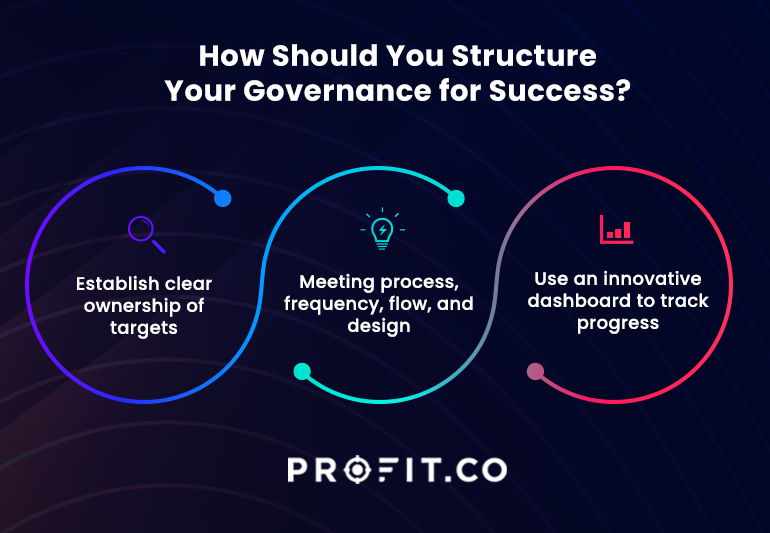Setting achievable, practical, and compelling goals requires time and effort. You may have sound objectives and key results (OKRs), but they will only be effective with a supporting structure or governance to ensure correct implementation.
Organizations need a way to measure, monitor, evaluate, and communicate performance and what areas to change or adjust.
Let’s explore corporate governance and its role in helping your organization get the most out of OKRs.
What is Corporate Governance?
Corporate governance is how management controls or governs a business or organization. This structure consists of processes, practices, and rules created by decision-makers with accountability and power.
Corporate governance makes it easier to handle the business or organization’s challenges. It ensures that you have adequate decision-making controls and processes to balance the needs and interests of everyone involved.
Corporate governance also covers the procedures of setting and pursuing objectives. The framework touches on every management aspect, from corporate disclosure to performance measurement, internal controls, and actions.
Corporate governance’s ultimate goal is to run the business or company in a way that enables the achievement of all goals and objectives.
Ideas are easy. Execution is everything. It takes a team to win.
Why is Governance Important for Successful OKRs?
Governance forms a system of practices and rules determining the best way to operate a business or company while aligning everyone’s interests. The primary benefits of this system combined with OKRs include the following.
Accountability
Governance and accountability go hand in hand. Governance drives accountability in that everyone understands the procedures and processes. When you merge your OKR system and governance, a highly-effective system holds everyone accountable for their performance.
Accountability is multi-faceted, as it involves two pillars. The first pillar is negotiation, where the goal is to approve OKRs. Your team will resonate better with OKRs if they are part of the discussion.
Have every team suggest OKRs and discuss them with their team leads to ensure the company goals align with the strategy and that there’s a shared understanding of the impact of OKRs on the business.
The group can discuss the following questions.
- Do the selected OKRs align with the company’s vision and goals?
- Are they practical based on the company’s strategies?
- Is everyone clear about their contribution?
- Is the level of stretch appropriate?
Most companies prefer writing OKRs from the bottom upwards. However, there should be a top-down discussion to ensure the selected OKRs will add value to the business.
The second pillar of accountability is retrospective. Retrospectives guarantee you won’t forget about the OKRs shortly after setting them. At the end of the quarter, it’s essential to hold a meeting to review and discuss the results.
Such meetings go beyond reporting the scores as you must examine what you learned about the business, what happened, why it occurred, and whether the OKRs add value to the company.
Alignment
OKRs are among the best tools to foster alignment within your company. Alignment can be bottom-up or top-down, horizontal, and strategic.

To learn more about what solutions would best suit your organization. Sign up with Profit.co today

Strategic alignment is vertical and addresses whether the objective aligns with the company’s strategies. Horizontal alignment handles how a team aligns with others to enhance cross-functionality.
Governance is vital to OKRs’ success because most employees rely on immediate team members and bosses. However, this confidence reduces when it comes to other departments.
You can implement OKRs, but they won’t automatically enhance cross-functional collaboration or eliminate such silos. Objectives and key results will only be effective if you have platforms for open discussions about shared OKRs and dependencies.
When defining OKRs, it’s crucial to establish dependencies so that everyone understands who in the company can offer specific assistance with an OKR. Ensure you note what each team needs and who can help, whether it’s advice, expertise, or actual work.
It would help if you also discussed dependencies across departments to establish whether every department can help.
Focus
The primary purpose of strategy execution systems is to help your team focus on essential aspects. Most companies struggle with OKRs because they select numerous OKRs as long as they can impact success rather than methodically narrowing down the most vital ones.
In such a case, governance is the key, providing a disciplined strategic approach when outlining OKRs. OKRs help you determine what you need to focus on and what’s essential and will add value to the business.
How Should You Structure Your Governance for Success?
Initially, we mentioned that your OKR system would only be effective if you had an effective governance structure behind them. Although there’s no one-size-fits-all way to structure your governance, some key things will help you achieve the desired results.

Establish clear ownership
As John Zinkin highlights in his book about corporate governance, The Challenge of Sustainability, leaders must find a way to reconcile ambiguity and adaptability, complexity with commitment and courage, and uncertainty with understanding.
The first step is determining who will take on the responsibility of managing and overseeing the continuous governance process. This responsibility covers duties such as:
- Compiling, managing, and sharing vital materials before and after every meeting
- Arranging key meetings
- Helping team members prepare for the meetings where necessary
Additionally, every key result or objective should have a particular person responsible for the overall OKR or owner. This owner collaborates with the governance process manager or owner to ensure consistent and continuous reporting across the entire OKR system. For instance, key dashboards should continually have updated numbers.
The process owner can also help OKR owners communicate better with crucial stakeholders while refining their plans and thoughts.
Meeting frequency, flow, and design
The governance process owner is primarily responsible for determining how and when to report progress on OKRs.
You should have OKR reviews that include the responsible teams to explain their progress and work. They should also involve leadership teams to review overall performance, maintain strategic alignment, and assist with roadblocks.
The meetings should be regular to ensure consistency since the process involves multiple departments. Although planning OKR meetings sounds simple, these meetings should be an effective way to track and report on progress.
Use an innovative dashboard.
While OKR owners focus on achieving the respective key results, having a customized dashboard is vital to share the progress on particular OKRs.
To avoid confusion, you should have a standardized dashboard for all OKRs so that the stakeholders and leaders can easily monitor and understand the progress of all OKRs.
Profit.co’s intuitive dashboard makes collecting, recording, processing, and reporting information easier. It combines data points and qualitative and quantitative insights for a comprehensive overview.
FAQs
- Why is corporate governance important?
Corporate governance provides a set of practices and rules that specify how a company runs and its goals align with stakeholder interests for financial viability.
- What are the benefits of governance when it comes to OKRs?
Integrating governance with OKRs ensures everyone remains focused, aligned, and accountable for their progress toward the overall goals.
Conclusion
A consistent governance system is crucial to drive and track progress with time. With a sound structure, you can truly reap the benefits of your OKR system.
Remember to establish clear OKR ownership and have regular meetings to drive continuous engagement if starting this process.

Sign up with Profit.co today to learn more about what solutions would best suit your organization.


